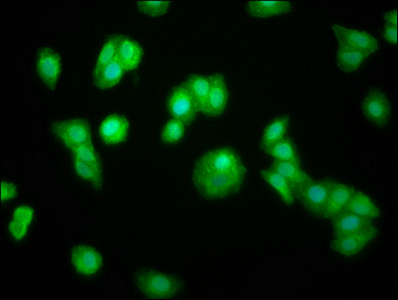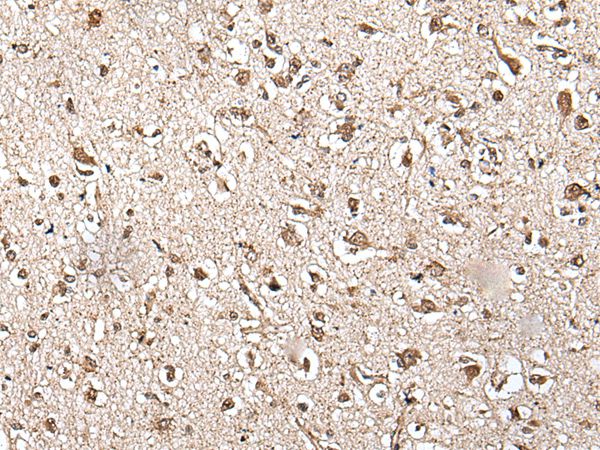
Immunofluorescence staining of HepG2 cells with CSB-PA026448LA01HU at 1:100, counter-stained with DAPI. The cells were fixed in 4% formaldehyde, permeabilized using 0.2% Triton X-100 and blocked in 10% normal Goat Serum. The cells were then incubated with the antibody overnight at 4°C. The secondary antibody was Alexa Fluor 488-congugated AffiniPure Goat Anti-Rabbit IgG(H+L).
ZFP36 Antibody
CSB-PA026448LA01HU
ApplicationsImmunoFluorescence, ELISA
Product group Antibodies
ReactivityHuman
TargetZFP36
Overview
- SupplierCusabio
- Product NameZFP36 Antibody
- Delivery Days Customer20
- ApplicationsImmunoFluorescence, ELISA
- CertificationResearch Use Only
- ClonalityPolyclonal
- ConjugateUnconjugated
- Gene ID7538
- Target nameZFP36
- Target descriptionZFP36 ring finger protein
- Target synonymsG0S24, GOS24, NUP475, RNF162A, TIS11, TTP, zfp-36, mRNA decay activator protein ZFP36, G0/G1 switch regulatory protein 24, growth factor-inducible nuclear protein NUP475, tristetraprolin, tristetraproline, zinc finger protein 36 homolog, zinc finger protein 36, C3H type, homolog
- HostRabbit
- IsotypeIgG
- Protein IDP26651
- Protein NamemRNA decay activator protein ZFP36
- Scientific DescriptionZinc-finger RNA-binding protein that destabilizes several cytoplasmic AU-rich element (ARE)-containing mRNA transcripts by promoting their poly(A) tail removal or deadenylation, and hence provide a mechanism for attenuating protein synthesis (PubMed:9703499, PubMed:10330172, PubMed:10751406, PubMed:11279239, PubMed:12115244, PubMed:12748283, PubMed:15187101, PubMed:15634918, PubMed:17030620, PubMed:16702957, PubMed:20702587, PubMed:20221403, PubMed:21775632, PubMed:27193233, PubMed:23644599, PubMed:25815583). Acts as an 3-untranslated region (UTR) ARE mRNA-binding adapter protein to communicate signaling events to the mRNA decay machinery (PubMed:15687258, PubMed:23644599). Recruits deadenylase CNOT7 (and probably the CCR4-NOT complex) via association with CNOT1, and hence promotes ARE-mediated mRNA deadenylation (PubMed:23644599). Functions also by recruiting components of the cytoplasmic RNA decay machinery to the bound ARE-containing mRNAs (PubMed:11719186, PubMed:12748283, PubMed:15687258, PubMed:16364915). Self regulates by destabilizing its own mRNA (PubMed:15187101). Binds to 3-UTR ARE of numerous mRNAs and of its own mRNA (PubMed:10330172, PubMed:10751406, PubMed:12115244, PubMed:15187101, PubMed:15634918, PubMed:17030620, PubMed:16702957, PubMed:19188452, PubMed:20702587, PubMed:20221403, PubMed:21775632, PubMed:25815583). Plays a role in anti-inflammatory responses; suppresses tumor necrosis factor (TNF)-alpha production by stimulating ARE-mediated TNF-alpha mRNA decay and several other inflammatory ARE-containing mRNAs in interferon (IFN)- and/or lipopolysaccharide (LPS)-induced macrophages (By similarity). Plays also a role in the regulation of dendritic cell maturation at the post-transcriptional level, and hence operates as part of a negative feedback loop to limit the inflammatory response (PubMed:18367721). Promotes ARE-mediated mRNA decay of hypoxia-inducible factor HIF1A mRNA during the response of endothelial cells to hypoxia (PubMed:21775632). Positively regulates early adipogenesis of preadipocytes by promoting ARE-mediated mRNA decay of immediate early genes (IEGs) (By similarity). Negatively regulates hematopoietic/erythroid cell differentiation by promoting ARE-mediated mRNA decay of the transcription factor STAT5B mRNA (PubMed:20702587). Plays a role in maintaining skeletal muscle satellite cell quiescence by promoting ARE-mediated mRNA decay of the myogenic determination factor MYOD1 mRNA (By similarity). Associates also with and regulates the expression of non-ARE-containing target mRNAs at the post-transcriptional level, such as MHC class I mRNAs (PubMed:18367721). Participates in association with argonaute RISC catalytic components in the ARE-mediated mRNA decay mechanism; assists microRNA (miRNA) targeting ARE-containing mRNAs (PubMed:15766526). May also play a role in the regulation of cytoplasmic mRNA decapping; enhances decapping of ARE-containing RNAs, in vitro (PubMed:16364915). Involved in the delivery of target ARE-mRNAs to processing bodies (PBs) (PubMed:17369404). In addition to its cytosolic mRNA-decay function, affects nuclear pre-mRNA processing (By similarity). Negatively regulates nuclear poly(A)-binding protein PABPN1-stimulated polyadenylation activity on ARE-containing pre-mRNA during LPS-stimulated macrophages (By similarity). Also involved in the regulation of stress granule (SG) and P-body (PB) formation and fusion (By similarity). Plays a role in the regulation of keratinocyte proliferation, differentiation and apoptosis (PubMed:27182009). Plays a role as a tumor suppressor by inhibiting cell proliferation in breast cancer cells (PubMed:26926077).
- ReactivityHuman
- Storage Instruction-20°C or -80°C
- UNSPSC41116161


